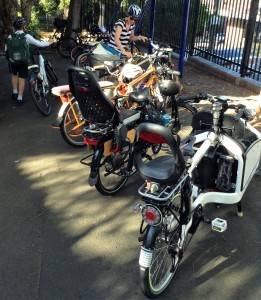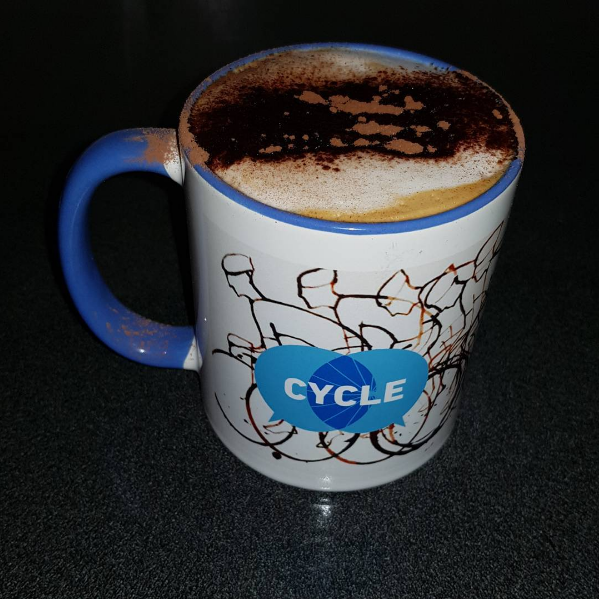Our family car is lonely. It sits on the street, day after day, not being used. Meanwhile, our cargo bike, which fits one parent and two kids, does at least 120km a week of riding. My husband and I sometimes squabble over who gets to take it for the day. In fact, our cargo bike is so useful that we've recently bought another one.
Cargo bikes have become popular in our neighbourhood and there are now five cargo bikes doing the regular drop off at our local primary school. Each carries two kids and a parent, totaling fifteen people carried by bicycle: without using petrol, taking up car parking space, or crowding out public transport. And the kids LOVE it. Turning up at the school gate in your personal chariot gets serious kudos, 'even' in the eastern suburbs of Sydney.
Our neighborhood is very hilly, with narrow, non-bike friendly streets and crappy footpaths. Which is why our kids won't be riding under their own steam for a few more years. It's also why we need electric assist: there's no way I could power up our street without it.
One of the advantages of having so many cargo bikes at the school is that we've been able to borrow and test a few.
The following article gives our opinion on the various cargo bikes we've tried out, and what we decided to buy. A follow up article describes how we imported our own cargo bike from overseas.
In our quest to find the next 'family sedan', we tried out the following bikes:
Front load:
- - Bullitt 'Larry vs Harry'
- Reise + Müller 'Load' *
- Butchers + Bicycles Mk-1 (3-wheel) *
- Nihola
- Christiana
Longtail:
- Yuba 'Mundo'
- Ezee 'Expidir'
- Yuba 'Spicy Curry' (not available in Australia yet)
- Xtracycle 'Edgerunner' (also not in Australia)
*Note: The models marked with * had Bosch motors.
As you can see from this list, there's a fairly wide range of cargo bikes, and they're all very different from each other. As an analogy, let's compare them to standard motor cars:
1) There's the el cheapo entry level cars (think Daewoo, Kia). The Ezee brand bikes and motors fit this category.
2) At the mid-range is Toyota which cheapish to buy, and functional, but doesn't have a big wow factor. This is the Yuba range of cargo bikes. The Bafung motor also fits this category.
3) The upper end Japanese cars - like Lexus and Honda - are equivalent to the Bullitt and Nihola from Denmark. Probably the Shimano Steps motor sits in this category as well.
4) And then there's the German luxury cars, which are higher quality in every aspect: ability to handle and manouvre, engineering, quality of finish, smoothness of the motor and transmission, and sheer joy factor. These are the Butchers + Bicycles, Reise + Müller, and top-end Xtracycles. And the Bosch motor.
Whilst this isn't a perfect analogy, it gives some indication of whet to expect.
ELECTRIC ASSIST
Unless you have legs of steel, or you live in a very flat area (Copenhagen, Melbourne) without wind (looking at you Perth), then you need electric assist. The bike with accessories weighs about 25kg, add two kids and their stuff (50kg), battery and motor (7kg) and your body weight. 150kg is a lot to schlepp up a hill from a standing start.
Once you get electric assist though, you'll never want another bike. I've done thousands more kilometres by bike simply because it's easy. When I have to take myself and/or the kids on a 5km round trip, it's a bit too far to walk, and bit short to drive (but I would have), and an absolute breeze on the electric bike.
In Australia there are strict regulations about electric-assist bicycles: it can only 'assist' your pedaling (i.e. You must be pedalling to get assistance from the motor); it can only assist up to 25km/hour (you can pedal faster but it won't assist above that); and a maximum 250 watt rating without a throttle or 200 watt rating with a throttle. A throttle gives an extra kick of power, to get started on a hill or at traffic lights, or when you need to power up suddenly to get through traffic. To put this in perspective, a strong bike rider can output around 200 watts, so it's like having another rider strapped to your bike.
So far, I've found that having a throttle is an absolute necessity to even get started on my street (which is a steep hill - there's probably there's a Strava King of the Mountain segment on it). Unfortunately, many electric bikes in Australia don't come with a throttle, and 250 watts doesn't help much for carting 150kg uphill. It's illegal to have more power assistance than this, but many people do DIY for obvious reasons. [I'm not sure what this would do for insurance, and I don't know if you can get a higher powered bike and register it. Any well-informed comments are welcome].
The Bosch motor doesn't have a throttle, but I have found that the torque sensor is so effective that I can get started on a steep hill without a throttle. This is not the case with other motors I've tried to date.
TYPES OF ELECTRIC MOTORS
Electric assist motors can be located on the front wheel, mid-drive, or the rear wheel hub.
- A front wheel hub is easy to fit, but a relatively inefficient way of powering a bicycle. If there's a lot of weight on the back, the front wheel can ride up in the air and lose traction. It also doesn't coordinate with the mechanical gears - but you'll work out the right mix with practice.
- A mid-drive motor is the most efficient location for assisting your pedalling, because it's right where you're putting your power. It can potentially be integrated with mechanical gears.
- A rear wheel hub usually requires an additional chain, which means extra maintenance. If there's a lot of weight on the back the hub may break more easily.
There are several brands of electric motors available in Australia. As mentioned earlier, the top of the range is Bosch. These only fit certain models of bikes, and are all mid-drive motors. There are licensed Bosch electric bike mechanics in Australia, which makes it appealing for servicing. The Bosch motor is superb - it's responsive to your pedalling (using a torque sensor), which feels like riding an automatic car. And it is FUN! Every cargo bike I've tried that has a Bosch motor I've wanted to ride straight home and keep. And every cargo bike without a Bosch has been ok, but not quite as awesome.
Other motors which you might see on cargo bikes include:
- Shimano Steps which has a torque sensor similar to the Bosch (I've only briefly ridden a bike with Steps, in Copenhagen which is flat, and didn't have much cargo so I can't readily compare)
- Bafung which has front, mid and rear hub options. We have a mid-drive which is pretty good for a cheaper DIY, but doesn't have the torque sensor.
- Ezee motors are generally located on the front wheel, and are pretty old technology,
- Bionx which is rear hub only, with regenerative power, and specific batteries
- Curry (not readily available in Oz).
BRAKES
If your bike goes forward, it also needs to stop in a controlled, predictable fashion. If you've got 150kg flying down a hill, you NEED good brakes.
Some cargo bikes are still supplied with v-brakes on the rims (and don't even mention roller brakes). You might survive in Melbourne, but anywhere else in Oz, you're dead. If you're ever likely to be riding down hill, with 150kg of cargo load, you'll need good quality, large-size mechanical discs, or preferably hydraulic disc brakes.
On our Bullitt bike we upscaled the mechanical disc sizes on both wheels to the maximum that the bike can take. It massively improved the safe braking distance.
STYLES OF CARGO BIKES
Generally, there are two styles of cargo bikes: those with the load on the front or those with the load on the back. These can come in two wheel or three wheel variants.
FRONT LOAD
With this style of bike, the load is on the front of the bike (like a courier) and the front wheel is long way forward of your handlebars. It takes practice to get used to, especially the 2-wheel version which requires arm strength and some core muscles. It's pretty alarming when a fully loaded bike starts to tip over: I dropped my kids 4 times... luckily on grass... but they were buckled in and wearing helmets.
The two big advantages of a front load, 2-wheel bike:
A) it's nimble and fast, which is why couriers have them
B) you can just chuck the kids, dogs, bags and surf boards in the loading bay and go.
The disadvantages are:
A) you absolutely can not kerb hop on one of these. Or lift it up over a kerb or stairs without serious upper body strength (or an assistant)
B) it's hard to take another adult. Young kids and dogs are a perfect fit, but any taller and it gets awkward with legs.
So, first on this review list is the Bullitt, by Larry vs Harry in Denmark. This is what we currently have. We bought it second-hand 18 months ago, so it's now about 7 years old. We installed a Bafung mid-drive electric motor, connected scooter lights to the battery, and up-specced the chain and other features. I've also tried the full electric version (Shimano Steps motor) when it was first released in Denmark.
For a handsome chunk of extra cash the Bullitt comes with a double seat for kids (padded leather seating, safety seat belts), rain covers, aluminum side panels etc.
The reach on the frame is big - I'm 167 cm and find it a long reach. I have to put the seat as far down as possible because I like to have my feet flat on the ground when stopped (so I don't drop the kids again). My husband is more comfortable with the size of the Bullitt. This can be compensated with different handlebar designs etc, but if you're short this bike is probably not a good fit. The Bullitt is a very solid workhorse, and has set the bar for what we're looking for in our next cargo bike purchase.
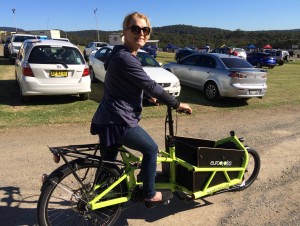 Next, the Riese + Müller 'Load'. I tried this bike on a go-kart race track, and could not stop smiling and laughing the whole way. It is more refined than the Bullit, with suspension and a Bosch motor, making it a dream to ride. If we were in the market to buy a front loading bike (and had the cash) I'd buy this in a heartbeat. The downside is the front load bay is fairly narrow, so you can't fit two Eskies like the Bullitt does. I'm sure with some clever panels you could get two kids side-by-side, but it's a bit squishy.
Next, the Riese + Müller 'Load'. I tried this bike on a go-kart race track, and could not stop smiling and laughing the whole way. It is more refined than the Bullit, with suspension and a Bosch motor, making it a dream to ride. If we were in the market to buy a front loading bike (and had the cash) I'd buy this in a heartbeat. The downside is the front load bay is fairly narrow, so you can't fit two Eskies like the Bullitt does. I'm sure with some clever panels you could get two kids side-by-side, but it's a bit squishy.
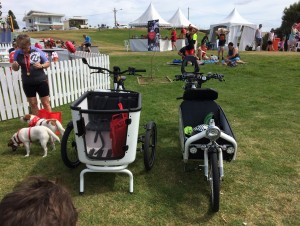 The Butchers + Bicycles Mk-1 tricycle is a seriously impressive piece of engineering. As a tricycle, it overcomes many of the disadvantages of a 2-wheel cargo bike (e.g. tipping over), and has a wide cargo bay that comfortably fits two kids side-by-side. It is also powered by a Bosch motor. But what makes this bike come into its own league is that it TILTS when you go around a corner. Incredible. This is not typical tricycle like the Christiana or Nihola - the tilting mechanism prevents it from tipping over so you can take corners with ease. The cargo bay has a little door in the front, so kids and dogs can hop in without lifting. Someone really thought about this! Beautiful engineering, and available in Australia.
The Butchers + Bicycles Mk-1 tricycle is a seriously impressive piece of engineering. As a tricycle, it overcomes many of the disadvantages of a 2-wheel cargo bike (e.g. tipping over), and has a wide cargo bay that comfortably fits two kids side-by-side. It is also powered by a Bosch motor. But what makes this bike come into its own league is that it TILTS when you go around a corner. Incredible. This is not typical tricycle like the Christiana or Nihola - the tilting mechanism prevents it from tipping over so you can take corners with ease. The cargo bay has a little door in the front, so kids and dogs can hop in without lifting. Someone really thought about this! Beautiful engineering, and available in Australia.
I've also tried both a Nihola and Christiana tricycle before, both from Denmark. They both have a smaller size frame than the Bullitt, but do have their own unique style of steering which takes a couple of days to get used to: they're like bath tubs with a rail for steering. The Nihola is more elegant, and its biggest ambassadors are Princess Mary of Denmark (Our Princess Mary!) and Vélo-a-Porter's Sarah Imm; both of whom demonstrate the elegance of riding in everyday chic; and the joy of transporting children by bike.
LONGTAIL
The Longtail cargo bike style handles more like a 'normal' bike, but fits a couple of people (or super size panniers) on the back. The advantages are:
A) you can get the front wheel over a kerb (back wheel when fully loaded not so much)
B) you can take another adult or taller child
C) easier to get used to compared to a front load.
The disadvantages are:
A) harder to take dogs (or goats, chickens etc), and
B) items have to be secured in panniers or strapped on the back (rather than simply chucking them in the cargo bay).
The Ezee Expidir and Boda Boda are amongst the cheapest options available. I haven't tried the Boda Boda, but I've borrowed an Expidir to test over a weekend. In summary, I hated it so much that I made my husband ride it back to the owner's house. Sure it's cheap, but you pay for what you get. Particularly if it has a front wheel motor with all the weight on the back, the front wheel can lose traction and power. It is entry level price, but I don't think I'd have become addicted to cargo bikes if I'd started with one of these.
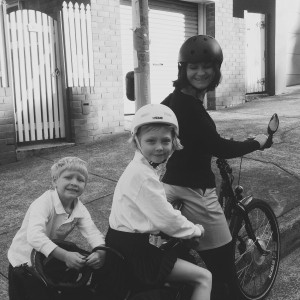
Yuba has a few cargo bikes options including the Mundo which has been around for years, and the new Spicy Curry which isn't available in Australia yet. The Mundo has a longer wheel base than most, which means it can fit up to three kids squeezed on the back. It's been couple of years since I rode one, so I can't compare it easily to the others reviewed here.
BUT! This month we went on holidays to the USA. While traveling around, we took the opportunity to try a few cargo bikes that aren't available in Australia. The first of these was the Yuba Spicy Curry. I could fit the two kids on the back, but had to load the heavier one in front otherwise the front wheel rode up in the air and I lost control of the bike. The Yuba Spicy Curry has a shorter wheelbase than the Yuba Mundo, which makes it more nimble but not as good for taking lots of kids. That's because you need their weight to be forward of the rear axle to prevent the front wheel from raising up.
Overall I enjoyed riding this bike, and I found it a much better bike than the Ezee Expidir, but it wasn't a wow experience. In part this was because the model I tried didn't have a throttle. It has a Curry motor that isn't well known in Australia. The motor has a torque sensor, but it was nowhere in the league of the Bosch motor.
Until the Yuba Spicy Curry is imported to Australia (which it might be in future) then it's not really a consideration.
Xtracycle has been around for a while. They started out with the 'Free Radical' a few years ago and have released several cargo bike models since then. Although Xtracycle doesn't currently import into Australia, I've heard of several people who have the Free Radical.
On our travels in the USA we came across a shop that had three Xtracycle Edgerunner styles to try. That was extremely useful: we tried different frame sizes (s/m vs large); and compared the 10e (top of the range) to some of the lower specced versions. I fell in love with the 10e model. It has a Bosch motor which was very responsive - despite not having a throttle I could easily get started uphill with a full load! I could fit the two kids on the back, and even having the heavier one furthest back didn't adversely affect the steering.
I found the smaller frame fit me better (but husband found it a bit short in the reach). The 10e Edgerunner comes with some nice quality features: Shimano Diore hydraulic disc brakes, Schwalbe Big Apple tyres (softer ride and puncture proof), and good quality shifter, grips, etc.
Verdict: SOLD! Despite the fact that no one in Australia currently imports the Xtracycle, and importing your own comes with serious logistics problems, I decided that this is the ideal bike to fit my current (and hopefully future) needs.
The next article describes how we imported the Cargo bike to Australia, including a mega bike box and an electric motor.

